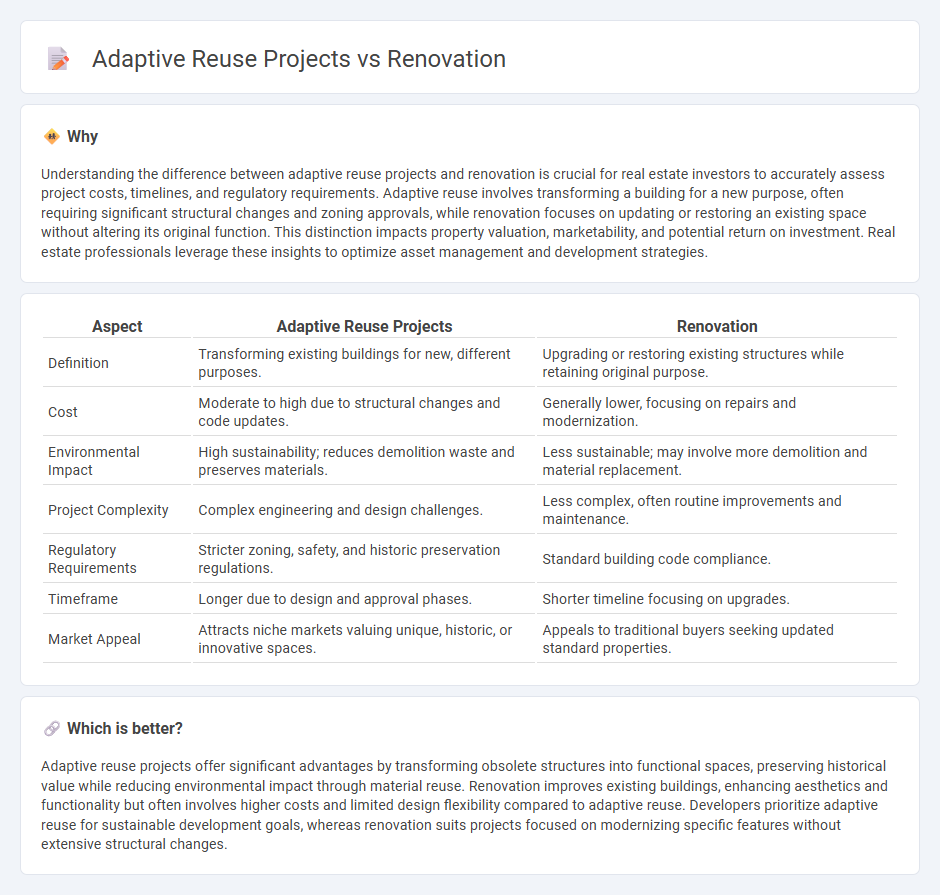
Adaptive reuse projects transform obsolete buildings into functional spaces, preserving historical elements while meeting modern needs. Renovation focuses on upgrading existing structures to improve aesthetics, safety, and performance without significantly altering the building's original purpose. Explore the benefits and challenges of both approaches to optimize your real estate investment strategy.
Why it is important
Understanding the difference between adaptive reuse projects and renovation is crucial for real estate investors to accurately assess project costs, timelines, and regulatory requirements. Adaptive reuse involves transforming a building for a new purpose, often requiring significant structural changes and zoning approvals, while renovation focuses on updating or restoring an existing space without altering its original function. This distinction impacts property valuation, marketability, and potential return on investment. Real estate professionals leverage these insights to optimize asset management and development strategies.
Comparison Table
| Aspect | Adaptive Reuse Projects | Renovation |
|---|---|---|
| Definition | Transforming existing buildings for new, different purposes. | Upgrading or restoring existing structures while retaining original purpose. |
| Cost | Moderate to high due to structural changes and code updates. | Generally lower, focusing on repairs and modernization. |
| Environmental Impact | High sustainability; reduces demolition waste and preserves materials. | Less sustainable; may involve more demolition and material replacement. |
| Project Complexity | Complex engineering and design challenges. | Less complex, often routine improvements and maintenance. |
| Regulatory Requirements | Stricter zoning, safety, and historic preservation regulations. | Standard building code compliance. |
| Timeframe | Longer due to design and approval phases. | Shorter timeline focusing on upgrades. |
| Market Appeal | Attracts niche markets valuing unique, historic, or innovative spaces. | Appeals to traditional buyers seeking updated standard properties. |
Which is better?
Adaptive reuse projects offer significant advantages by transforming obsolete structures into functional spaces, preserving historical value while reducing environmental impact through material reuse. Renovation improves existing buildings, enhancing aesthetics and functionality but often involves higher costs and limited design flexibility compared to adaptive reuse. Developers prioritize adaptive reuse for sustainable development goals, whereas renovation suits projects focused on modernizing specific features without extensive structural changes.
Connection
Adaptive reuse projects transform existing buildings for new purposes by integrating renovation techniques that update structural elements, systems, and aesthetics to meet modern standards. Renovation serves as a critical component of adaptive reuse by enhancing functionality and extending the lifespan of real estate assets while preserving historical or architectural significance. This synergy supports sustainable development, reduces construction waste, and maximizes property value in competitive real estate markets.
Key Terms
Scope of Work
Renovation projects primarily involve upgrading and restoring existing structures to improve functionality and aesthetics while maintaining the original design. Adaptive reuse projects transform buildings for new purposes, often requiring substantial modifications to accommodate different uses or modern standards. Explore the detailed scope of work differences to determine the best approach for your construction goals.
Building Codes
Renovation projects often must comply with current building codes, requiring updates to meet safety, energy efficiency, and accessibility standards, which can drive up costs and complexity. Adaptive reuse projects face unique challenges, as they integrate new uses into existing structures while navigating exemptions or variances in building codes, particularly for historic or industrial buildings. Discover how to strategically approach building code compliance in renovation and adaptive reuse for successful project outcomes.
Historic Preservation
Historic preservation projects often involve either renovation or adaptive reuse, each with distinct benefits for maintaining cultural heritage. Renovation focuses on restoring original architectural elements to their former condition, while adaptive reuse transforms historic buildings for new purposes, enhancing sustainability and community value. Explore these approaches to understand how they balance history with modern needs in preservation efforts.
Source and External Links
Renovation - Wikipedia - Renovation involves improving broken, damaged, or outdated structures through several phases, including project initiation, existing conditions analysis, and construction.
Renovate vs. Remodel: What's the Difference? - Lowe's - This article explains the differences between renovation and remodeling, focusing on cost, scope, and materials needed for each type of project.
What's The Difference Between A Home Renovation & A Remodel? - This piece highlights the distinction between renovations (minor aesthetic updates) and remodels (major structural changes), addressing costs, labor, and project scope.
 dowidth.com
dowidth.com